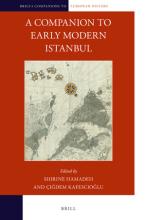At a time when most public spaces were intended for men, what kind of discourses developed around various forms of masculinities that can be tied to particular types of spaces in Istanbul?
Very soon after the conquest, Istanbul became a stage where Ottoman elite men displayed new forms of etiquette that went along with new codes for an imperial ideology. The structuring of the city developed around public spaces mostly intended for men. The court, the medreses, the mosques, the market district, military barracks, taverns and bathhouses became grounds for interaction among different groups of men and those found reference in documents and narratives.
Drawing on a myriad of documentary and narrative sources, such as Latifi’s Evsaf-i Istanbul, Aşık Çelebi’s Meşairü’ş-şuara, Gelibolulu Ali’s Kavaidü’n-mecalis, Hoca Sadeddin’s Tacü’t-tevarih, Atayi’s Hamse, letter compilations and judge records, this chapter investigates the performance of masculinities on sacred and profane spaces that are formed, as they defined, the interaction of men among men.
Istanbul: City of Men
“Istanbul: City of Men,” in Brill Companion to Early Modern Istanbul, edited by Shirine Hamadeh and Çiğdem Kafesçioğlu (Leiden: Brill 2021), 62-85
